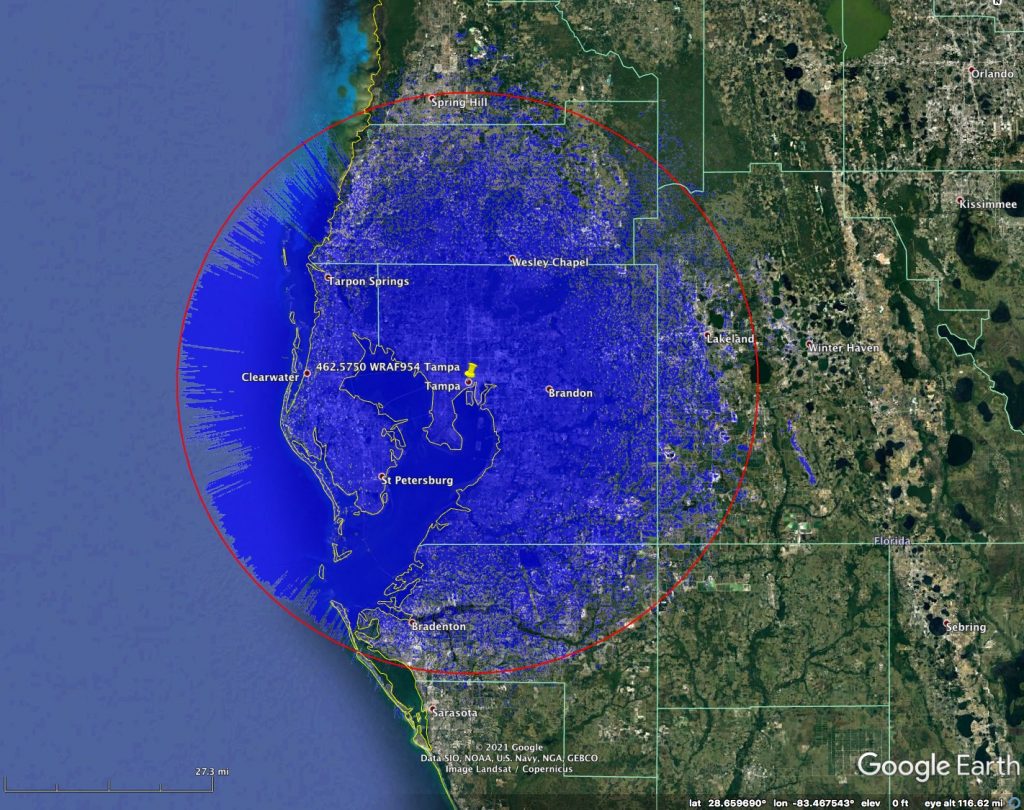Problem
Recently our users have experienced severe interference on the 462.5750 repeater input (467.5750). Initially it was though this was FRS 8 or 9 users on splinter channels. FRS 8 and 9 are 467.5625 and 467.5875 respectively and is a 12.5 KHz wide Narrow Band User. A FRS user on either of these channels would have a 1.35 KHz overlap with the repeaters pass band on its input, and potentially 2.45 KHz with a worst case permitted 2.5 PPM drift.
Remotely, we were able to put the repeater into Carrier Squelch mode (“CSQ”), and listen. It was immediately clear these were not off frequency signals of FRS users, but rather on frequency commercial operators. Commercial operation under part 90 is not permitted on this frequency, and stranger still, there appeared to be multiple operators using this as both and input and an output for their repeaters.
Research was done, and it was found these frequencies were used for ship board repeaters and the port of Tampa. As this is under 1 mile from the repeater site, these ships running a 5w hand held or 25w repeater on the input cause severe interference to GMRS repeater receiver. Research showed these users are legal and permitted by the FCC for ship board use. The shipboard channels are 10 MHz split 457.5250/456.5250, 457.5500/457.550, and 457.5750/467.5750; these last two overlap with GMRS and are only available to non-US users. US flagged vessels are under the FCC authority and 47 CFR 80.373(g)1 specifies 4 channels 457.525/467.750, 457.550/467.775, 457.575/467.800, and 457.600/467.825 with the lower being the repeater output. Note these are 10.225 MHz split and this appears intentional to keep users off GMRS repeater inputs.
Solutions
There is not much GMRS users can do to have these users shut down in the port, as these users come and go as fast as they can offload their cargo at the port. Perhaps asking the port authority to have ships curtail their use, however most are unaware of the channels they are on.
FSG soultion
Our repeater is not on a duplexer, but rather a split TX/RX antenna system. The transmit antenna uses a RF combiner consisting of tuned circuits to combine multiple transmitters onto a single antenna. The receiver antenna has dual 4 MHz wide filters on centered 458 and 468 MHz feeding a low noise, high gain pre-amplifier and then receiver multi-coupler. This provides some frequency flexibility as the transmitter frequency cannot easily be moved, but the receiver frequency may be moved.
Our tech committee has enabled scanning mode on the receiver. It will listed on 467.5750 141.3 Hz and 467.7250 D546, and scan between these frequencies. This does introduce a slight delay when using the repeater, but most users should have a half second delay upon key-up before starting to speak as this is good radio practice. Note the P25 NAC is still 0x575 on both.
What many users do is program “Tampa 575 FSG” and “Tampa 575 FSG'” in their radio, with the prime channel being the alternate input. Some purpose built GMRS radios may not support this or likely support it but must be programed via a computer to do it.
References
ITU–R M.1174–3 – Technical characteristics of equipment used for on–board vessel communications in the bands between 450 and 470 MHz
47 CFR § 80.373 – Private communications frequencies.
47 CFR § 2.106 – Table of Frequency Allocations :
US287 In the maritime mobile service, the frequencies 457.525 MHz, 457.550 MHz, 457.575 MHz, 467.525 MHz, 467.550 MHz and 467.575 MHz may be used by on-board communication stations. Where needed, equipment designed for 12.5 kHz channel spacing using also the additional frequencies 457.5375 MHz, 457.5625 MHz, 467.5375 MHz and 467.5625 MHz may be introduced for on-board communications. The use of these frequencies in territorial waters may be subject to the national regulations of the administration concerned. The characteristics of the equipment used shall conform to those specified in Recommendation ITU-R M.1174-2.
